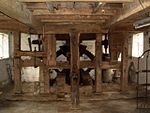Trafford Hall
Country house hotelsCountry houses in CheshireGeorgian architecture in CheshireGrade II* listed buildings in CheshireGrade II* listed houses ... and 4 more
Hotels in CheshireHouses completed in 1756Use British English from May 2021Youth hostels in England and Wales

Trafford Hall is an 18th-century country house standing to the east of the village of Wimbolds Trafford in Cheshire, England, about 4+1⁄2 miles (7 km) northeast of the city of Chester. It is owned by The Regenda Group and operated as a youth hostel and training centre by the Youth Hostels Association.
Excerpt from the Wikipedia article Trafford Hall (License: CC BY-SA 3.0, Authors, Images).Trafford Hall
Ince Lane, Chester Mickle Trafford and District
Geographical coordinates (GPS) Address Phone number Website Nearby Places Show on map
Geographical coordinates (GPS)
| Latitude | Longitude |
|---|---|
| N 53.2436 ° | E -2.82 ° |
Address
Sandfield Golf Course and Driving Range
Ince Lane
CH2 4JP Chester, Mickle Trafford and District
England, United Kingdom
Open on Google Maps










